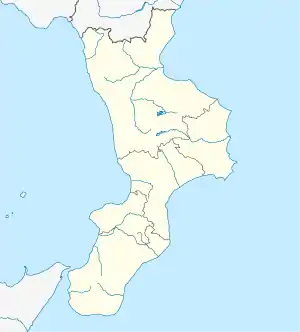Acquaformosa | |
|---|---|
| Comune di Acquaformosa | |
01.png.webp) | |
Location of Acquaformosa | |
 Acquaformosa Location of Acquaformosa in Italy  Acquaformosa Acquaformosa (Calabria) | |
| Coordinates: 39°43′N 16°06′E / 39.717°N 16.100°E | |
| Country | Italy |
| Region | Calabria |
| Province | Cosenza (CS) |
| Government | |
| • Mayor | Gennaro Capparelli |
| Area | |
| • Total | 22.71 km2 (8.77 sq mi) |
| Elevation | 756 m (2,480 ft) |
| Population (31 December 2016)[2] | |
| • Total | 1,106 |
| • Density | 49/km2 (130/sq mi) |
| Demonym | Acquaformositani |
| Time zone | UTC+1 (CET) |
| • Summer (DST) | UTC+2 (CEST) |
| Postal code | 87010 |
| Dialing code | 0981 |
| Patron saint | St. John the Baptist |
| Saint day | August 29 |
| Website | Official website |
Acquaformosa (Arbëreshë Albanian: Firmoza) is a town and comune in the province of Cosenza in the Calabria region of Italy. Since the Middle Ages it is home to an Arbëresh minority, which is reflected in the presence of Skanderbeg's heraldic eagle in the comune's coat of arms. The town is also the seat of the Arberesh Orthodox Church.
History
The town of Acquaformosa was originally the site of the Monastery Santa Maria di Sambucina di Luzzi, founded in 1195, and populated by a handful of Catholic monks.
In 1501, 15 families totaling 22 people arrived from Albania. The families, led by Martino Capparelli, Pellegrino Capo and Giorgio Córtese, fled their home country to escape persecution from conquering Muslims from the Ottoman Empire.[3] The Albanians sought permission to build a permanent settlement near the monastery. That permission was granted officially in 1506, in an accord that included payment of grains per head of livestock in the territory.[4] The first child born to the settlers was in 1504.
Today, the surnames of many of the original settlers still make up a majority of the population in Acquaformosa, including Capparelli and Buono.[5]
Language
While Italian is spoken by residents of Acquaformosa, the Arbëresh language is still widely spoken by the local population. Arbëresh is derived from 15th century Albanian, as it was spoken when the original immigrants fled Albania at the beginning of the 16th century. The language has since evolved, absorbing many Italian phrases and idioms, and is distinctly different from modern Albanian.
References
- ↑ "Superficie di Comuni Province e Regioni italiane al 9 ottobre 2011". Italian National Institute of Statistics. Retrieved 16 March 2019.
- ↑ "Popolazione Residente al 1° Gennaio 2018". Italian National Institute of Statistics. Retrieved 16 March 2019.
- ↑ De Marchis, Domenico (1857). Breve cenno monografico-storico del Comune di Acquaformosa. Salerno: Raffaele Migliaccio.
- ↑ "I Paese Arbëreshë". Ungra. Retrieved 18 February 2018.
- ↑ "Town of Acquaformosa". Towns and Villages of Italy. Retrieved 18 February 2018.